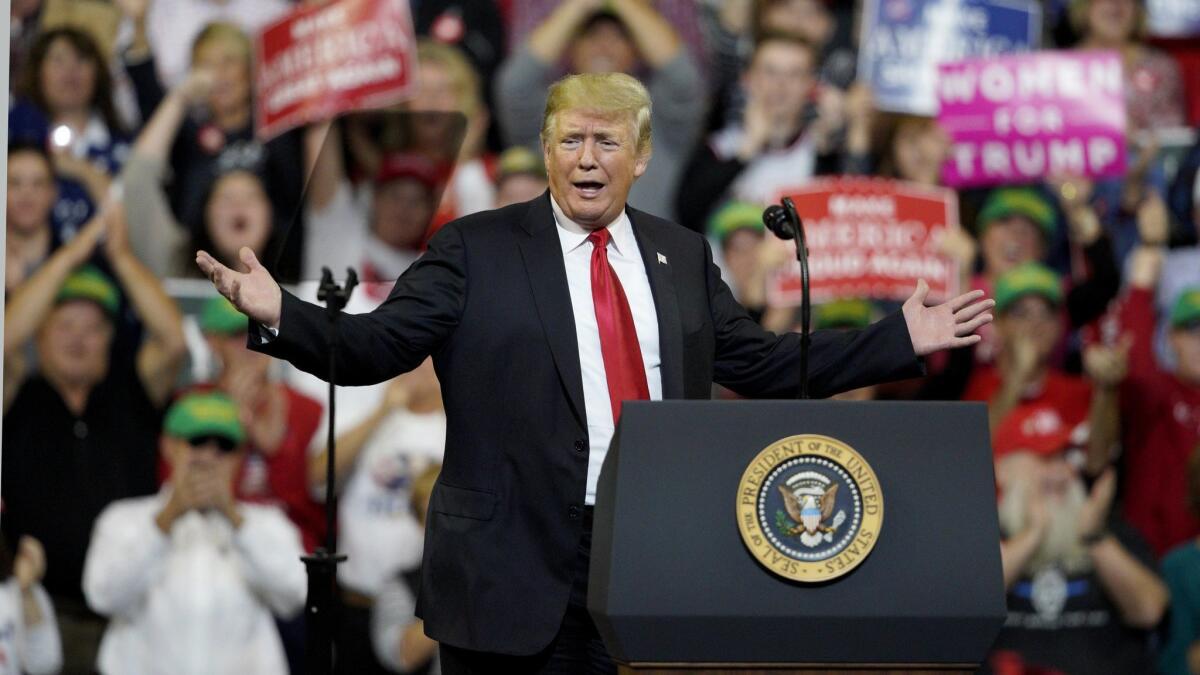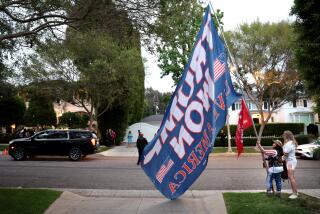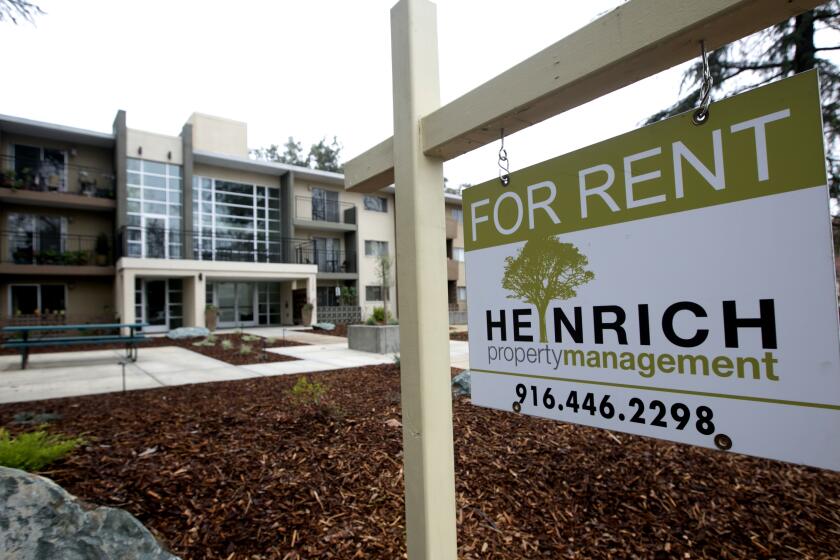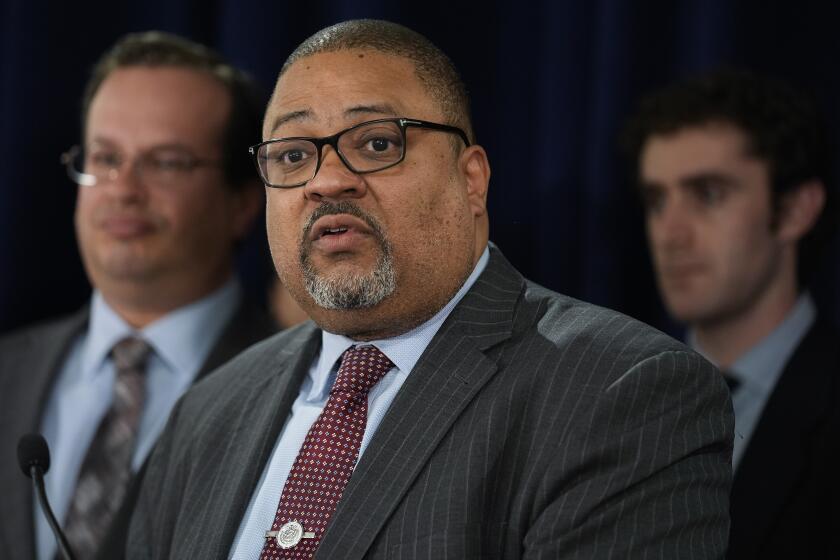Mapping Trump’s ‘MAGA’ rallies: Mostly red states and off the beaten political paths

Standing in a drizzle in this southwestern Iowa city, in a line that snaked around the arena and an adjacent field house, the people in red hats and raincoats were nonetheless cheery and eager, even those who traveled hours to be there.
“You don’t get many opportunities to be in the same room as the president,” said Sarah Beach, who drove from Lincoln, Neb., with her family.
President Trump wouldn’t land for another hour, but the people waiting Tuesday evening to enter Mid-America Center, an arena just off Interstate 80 near a truck stop, a Horseshoe Casino and a Hooters, were enjoying the wait and the anticipation of an experience they’ve seen so many times on television.
This was the first of four “Make America Great Again” rallies he would hold this week, and the president’s appearance here, on the border between two Republican-red, rural heartland states, marked yet another visit to Trump country — places far from major cities and the coasts where his audience is mostly white, blue-collar and loyal.
“I’m proud as heck of Trump,” said Tom Carls, explaining why he and his wife of 45 years, Debbie Carls, had driven eight hours from Sycamore, Ill. “I’d stand in front of somebody if they tried to shoot him. He’s just a good person. I know he says a lot of dumb things, but it is what it is. He’s himself.”
If they had to stand in the rain, so what? “To see him, I’d do it forever,” said Carls, wearing a hat noting his service in Vietnam. His wife clutched his military discharge form and one of his medals, in case they needed to talk their way in. “I just thought it might help,” she said.
Whether in Iowa or his next night’s stop, Erie, Pa., where Trump lands is no accident: “You see him in states and markets where his policies are the most popular and where Democrats have been least supportive,” Bill Stepien, the White House political director, said in an interview.
Of 34 cities where Trump has held rallies since taking office, counting a scheduled event Saturday night in Richmond, Ky., only three are among the country’s 30 most populated: Phoenix, Las Vegas and Nashville. Most are not cities at all. Charting his stops yields a map that reflects his base, mostly red states and rural communities — a base that he hasn’t tried to expand upon.
Since early in his presidential campaign, when Trump traveled beyond early-voting states like Iowa and New Hampshire — to places like Mobile, Ala., and Springfield, Ill.; Lowell, Mass., and Beaumont, Texas — he has often gone where rivals and past presidents didn’t. Many are places that have struggled economically and where people are unaccustomed to such visits, in keeping with his professed appeal to “the forgotten men and women.”
The president’s schedule is driven by shifting calculations about the midterm election now less than four weeks away. While he has been welcomed in places like Elkhart, Ind., Springfield, Mo., and Wheeling, W.V. — red states where Republicans are trying to unseat Democratic senators — Trump has steered clear of battlegrounds in Florida, California and New Jersey, where control of the House may be decided but he is an especially polarizing figure.
After a number of trips in August and September aimed primarily at boosting Republican Senate hopefuls — all but one of them (Nevada) in states he won in 2016 — Trump has recently been campaigning mostly for House candidates, hoping to prevent Democrats from winning the 23 seats they need for a majority.
But the locations also are similar to the places he visited as a candidate in 2016 and reflect his own calculations for the 2020 reelection effort. Iowa, for instance, is a politically beneficial destination for 2020 as well as 2018.
In Council Bluffs, however, Trump joked about his surprise that much of the crowd seemed to be from Nebraska.
He recognized among the crowd, and endorsed, Iowa Gov. Kim Reynolds, a Republican seeking a second term, and Rep. David Young, who is in a tight race to hold his House seat, branding their opponents as “extremists” and falsely alleging the Democrats “will end ethanol,” the fuel blend made with corn, much of it from Iowa.
But he also referenced two Nebraska Republican incumbents, Reps. Don Bacon and Jeff Fortenberry, and that state’s governor, Pete Ricketts. More than most rallies, this one straddling two farm states had many green Trump caps among the red ones, reading “Make Our Farmers Great Again.”
“This is my first rally,” said Andrew Eberspacher, a farmer from Seward, Neb., wearing one of the green hats, which he’d purchased on the Trump campaign website along with two for the friends with him.
Trump, he said, “has struck a nerve with the American people to wake them up from where they’ve been, so I think that’s where you see the enthusiasm coming from.”
The president’s blunt-force attack lines against Democrats are meant to benefit Republican candidates and energize voters. He has taken to describing Democrats as “an angry mob,” “wacko” and “unhinged” and has said they seek to drive the country “maybe into poverty and ultimately into chaos.”
After the Iowa rally, the next night Trump was in Erie, Pa., vowing to help Rep. Mike Kelly with a promise to replenish sand alongside a local lake and also vouching, as he has before, for the Republicans’ Senate candidate, Rep. Lou Barletta, running against Democratic Sen. Bob Casey. Trump has lost support in Pennsylvania, however, after capturing the state in 2016 on the strength of votes from working-class whites.
As Trump stumps the country, so does Vice President Mike Pence, in what political aides call a division of labor — one that allows Pence to fill in where the president may not be helpful. Pence rather than Trump campaigned this week in suburban Dallas for Rep. Pete Sessions, a senior House Republican who’s facing a tougher-than-expected reelection fight, largely due to Trump’s toxicity with more-educated Republicans in the suburbs.
Political advisors figure that up to 60% of those attending Trump rallies are Republicans and the rest are folks drawn to him, not the party; the goal is to persuade that latter group to vote for the local candidates he’s there to endorse.
“He has tended to be pretty open to going where he is helpful and where he is not helpful,” said one official at the Republican National Committee, who spoke on the condition of anonymity to discuss how the party works with the White House to determine the fall campaign travel schedule.
Trump’s appearances, the official said, generate significant revenue for the RNC — he typically holds high-dollar fundraisers before the rallies — as well as a surge in volunteer sign-ups and get-out-the-vote, or “GOTV,” efforts. Every rally attendee must submit their email address, which party officials then use to follow up with information about voter registration deadlines and repeated reminders to vote.
Even so, some Republican consultants, especially those with eye on swing districts crucial to the party’s chances of holding on to its congressional majorities, worry that the intensity of Trump’s efforts to fire up the base will backfire with more moderate voters.
“He fires up the Republican base, but he also reminds Democrats of the stakes,” said Alex Conant, a Republican media consultant who worked for Florida Sen. Marco Rubio’s presidential campaign in 2016.
“There’s no question that when he goes to North Dakota and West Virginia, it helps those candidates,” Conant said, adding, “If he goes to red states and delivers his message and doesn’t make news that dominates the national conversation the next day, that is very helpful. When he goes and makes comments that will distract from the message in swing suburbs, it’s problematic.”
With polls suggesting Republican enthusiasm rising a bit after the fight over Justice Brett Kavanaugh’s confirmation to the Supreme Court, some Republican candidates in turn are gaining in a number of Senate races, including those in Missouri, Montana and West Virginia, states where Trump is likely to hold additional rallies over the final weeks before election day.
But even in these red states, not all of Trump’s supporters are a lock to support the candidates he’s stumping with.
Jill Mowery, a nurse from Council Bluffs, stood on her feet for much of Trump’s 76-minute speech here, and she wasn’t alone. That doesn’t mean she plans to vote for Young or Reynolds, the Republican candidates, just because they’ve got Trump’s endorsement and an R next to their names on the ballot.
“I’m not going to vote strict Republican,” she said. “I’m going to vote whatever I think is good. I’m not just going to do what he says.”
As much as she loves the president’s “spirit,” she said, she’s tired of the intense partisanship in Washington.
“I want something done,” Mowery said. “I’m kind of mad that both those parties are up there fighting like a little bunch of girls. We pay them a bunch of money to get something done, and all that money’s being wasted with all the fighting and crap that they’re doing.”
More to Read
Get the L.A. Times Politics newsletter
Deeply reported insights into legislation, politics and policy from Sacramento, Washington and beyond. In your inbox three times per week.
You may occasionally receive promotional content from the Los Angeles Times.







